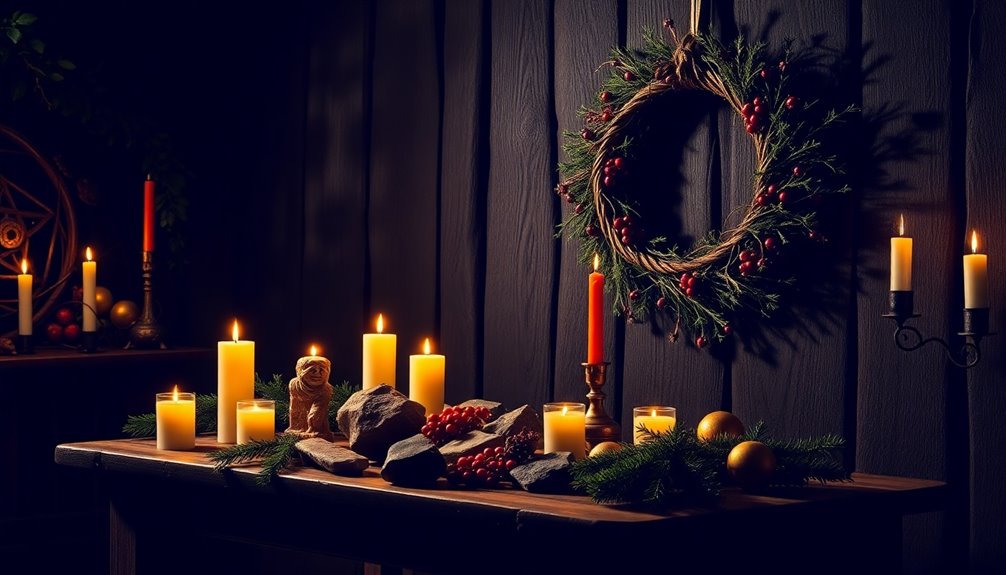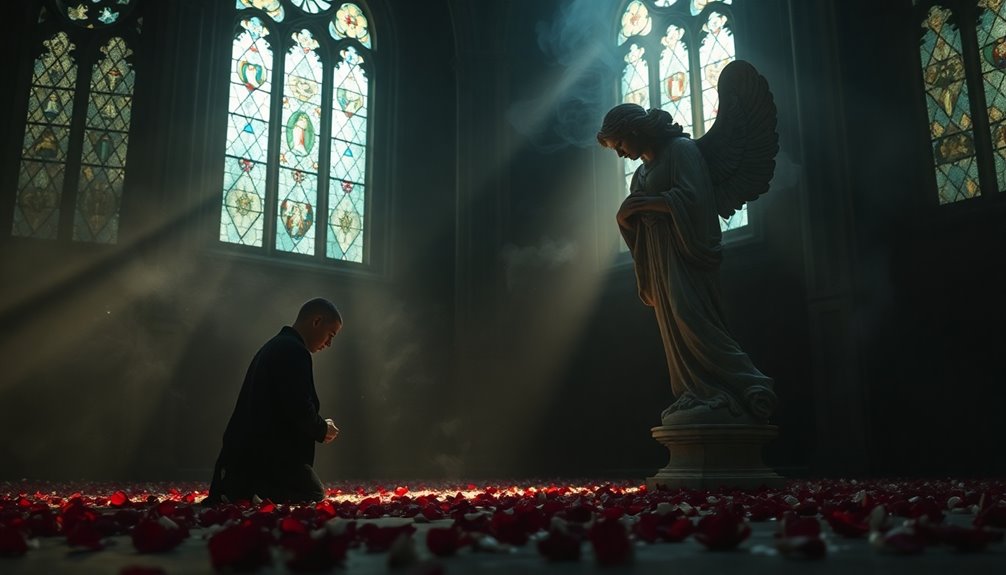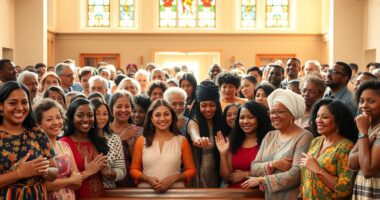Christmas has roots in pagan traditions, particularly from winter solstice celebrations like Saturnalia and Yule. The early Church chose December 25 to coincide with these festivals, creating a blend of customs. While many Christmas practices, such as gift-giving and decorating trees, have origins in these pagan customs, they've evolved to focus on celebrating the birth of Jesus and communal unity. It's crucial to recognize that Christmas today represents both religious and cultural aspects, making it a unique holiday. If you explore further, you'll uncover more about the fascinating connections between Christmas and its diverse traditions.
Key Takeaways
- Christmas was strategically set on December 25 to coincide with pagan winter solstice festivals, blending Christian and pagan traditions.
- Elements like the Christmas tree and gift-giving have roots in ancient pagan customs, yet they have evolved to symbolize Christian themes of hope and renewal.
- The winter solstice, celebrated globally, influenced Christmas customs, such as feasting and communal gatherings, showcasing cultural blending.
- Misinterpretations of biblical texts, like Jeremiah 10:2-4, often confuse tree symbolism with idolatry, rather than acknowledging its Christian significance.
- While Christmas incorporates pagan elements, it has transformed into a distinctly Christian celebration reflecting both religious beliefs and cultural diversity.
Introduction
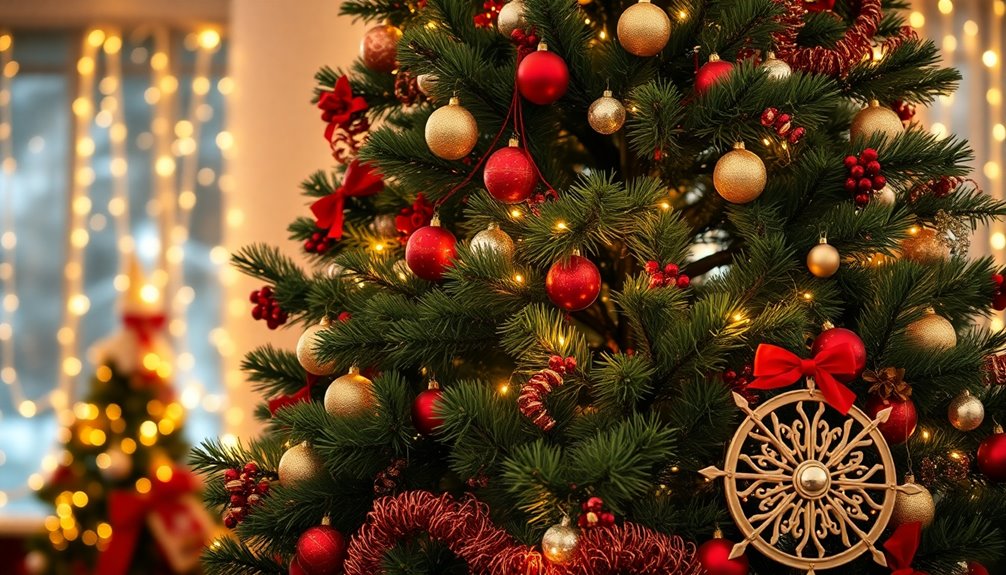
Christmas is often viewed through a lens of controversy, with many questioning its origins and connections to pagan traditions. You might hear claims that the holiday is merely a repackaged pagan celebration, but the truth is more nuanced.
December 25 was chosen by the early Church to align with existing pagan winter solstice festivals, like Saturnalia and Yule. This strategic decision aimed to transform those celebrations into a Christian context, focusing on the birth of Jesus rather than ancient customs.
While it's true that many modern Christmas traditions—such as gift-giving, feasting, and evergreen decorations—have roots in pagan customs, these practices evolved within a distinctly Christian framework by the 4th century.
The early Church didn't just adopt these traditions; they reinterpreted them to emphasize hope and renewal in the context of Jesus' birth.
Biblical View on Trees
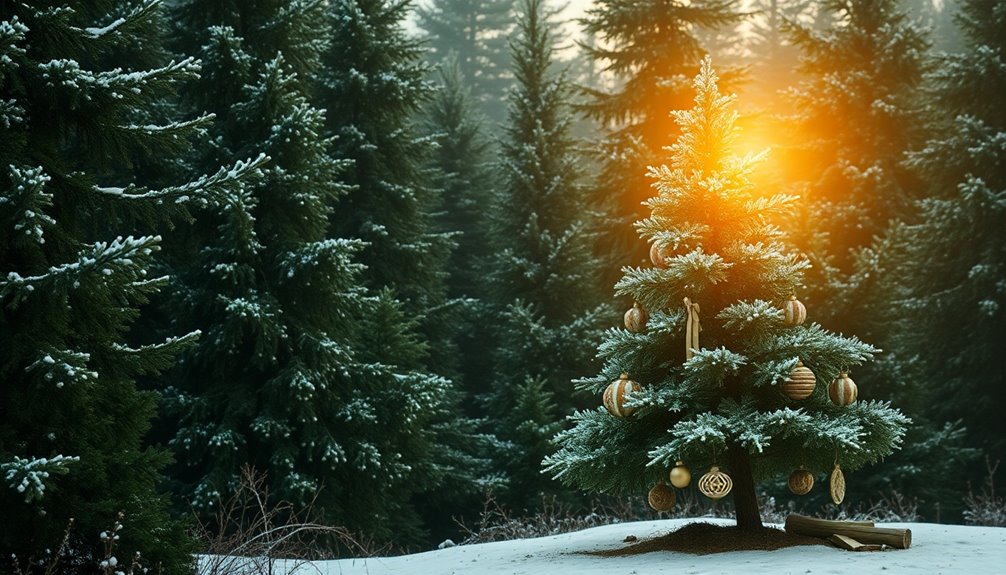
When you look at trees in the Bible, you'll find both warnings and blessings.
For instance, Jeremiah cautions against using trees for idolatry, while other passages celebrate their significance in God's plans.
This makes it essential to explore how these references shape our understanding of trees in relation to modern traditions, including the Christmas tree.
Primary Bible References
While many associate evergreen trees with Christmas celebrations today, the Bible offers a nuanced perspective on trees that doesn't directly connect them to this holiday. In Jeremiah 10:2-4, you're warned against adopting pagan practices, particularly the worship of wooden idols. While this passage discusses cutting down trees and decorating them, it isn't specifically about Christmas trees.
The Hebrew Bible shows trees as symbols of life and creation but doesn't mention them in the context of Christmas celebrations. In the New Testament, there's no reference to Christmas trees; early Christians celebrated Jesus' birth without incorporating specific tree rituals.
The tradition of using evergreen trees for Christmas emerged much later, primarily during the Renaissance in Germany, diverging from ancient biblical customs.
Colossians 2:16-17 emphasizes that you're free from judgment regarding festivals and observances, suggesting that your choice to celebrate with trees should stem from personal conscience rather than a biblical mandate.
Ultimately, while trees hold significance in scripture, their use in Christmas celebrations lacks a direct biblical foundation, raising questions about their pagan origins.
Secondary Bible References
The Bible provides various references to trees that highlight their significance beyond mere decoration. In Jeremiah 10:2-4, God warns against crafting wooden idols, which some critics reference to argue against the Christmas tree. However, this passage addresses idolatry, not the cultural use of trees in festive contexts.
The Christmas tree, popularized in the 19th century, symbolizes hope and eternal life, aligning with the Christian celebration of Christ's birth.
It's important to recognize that ancient pagan practices involved different intentions. Early Christians, as noted by Tertullian, adapted cultural customs like wreaths without idolatrous intent. While some may see pagan roots in the tree tradition, it has evolved into a symbol of life and renewal, resonating with biblical themes of hope.
The Christmas tree serves as a reminder of God's creation and the gift-giving spirit of the season. When you decorate your tree, you're participating in a tradition that transcends its pagan origins, focusing instead on the joy and meaning of the Christian celebration. Additionally, engaging in festive activities can enhance emotional well-being and strengthen community bonds during the holiday season.
This perspective allows you to embrace the Christmas tree's beauty and significance in a way that honors your faith.
Pagan Winter Solstice Celebrations
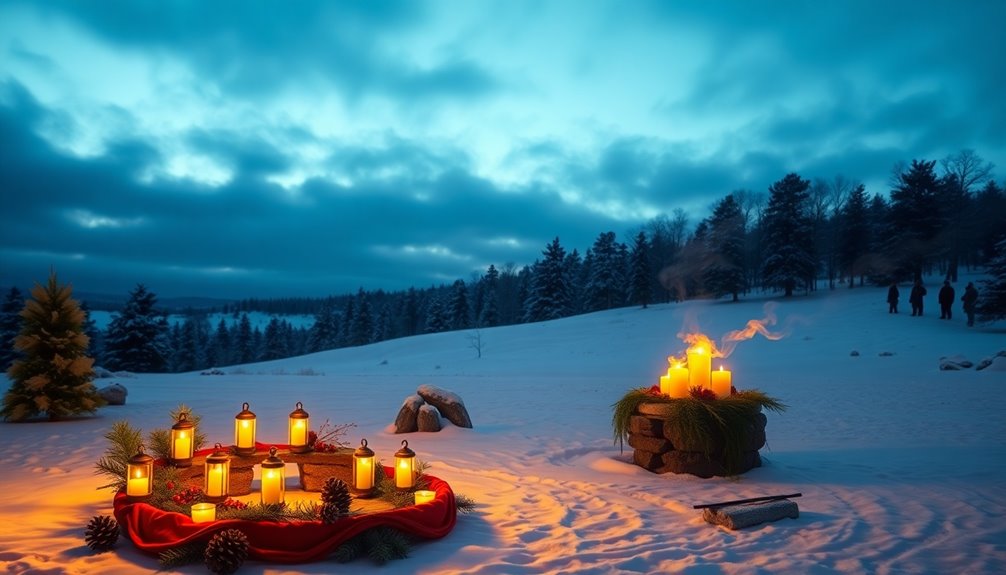
Winter solstice celebrations have long been a beacon of hope and renewal for various cultures, marking the shortest day of the year. For ancient Romans, the festival of Saturnalia, celebrated from December 17th to 24th, was a time of revelry and joy. During this pagan holiday, people engaged in feasting, gift-giving, and merrymaking, creating a festive atmosphere that brought communities together.
Similarly, the Norse celebrated Yule, a 12-day festival filled with bonfires, feasting, and the sacred Yule ham. These gatherings not only honored the return of light but also reinforced bonds within families and communities.
Interestingly, December 25th marked the climax of Saturnalia and the festival of Brumalia, which emphasized the cultural significance of this date well before Christmas emerged as a holiday.
Moreover, the birthday of Dionysus, celebrated on December 25th, reflects the intertwining of various pagan customs with the winter solstice festivities. As you explore these ancient practices, you can see how they shaped the seasonal celebrations that many still cherish today.
Understanding these roots helps illuminate the connections between pagan traditions and modern winter festivities.
Yule's Influence on Christmas Traditions
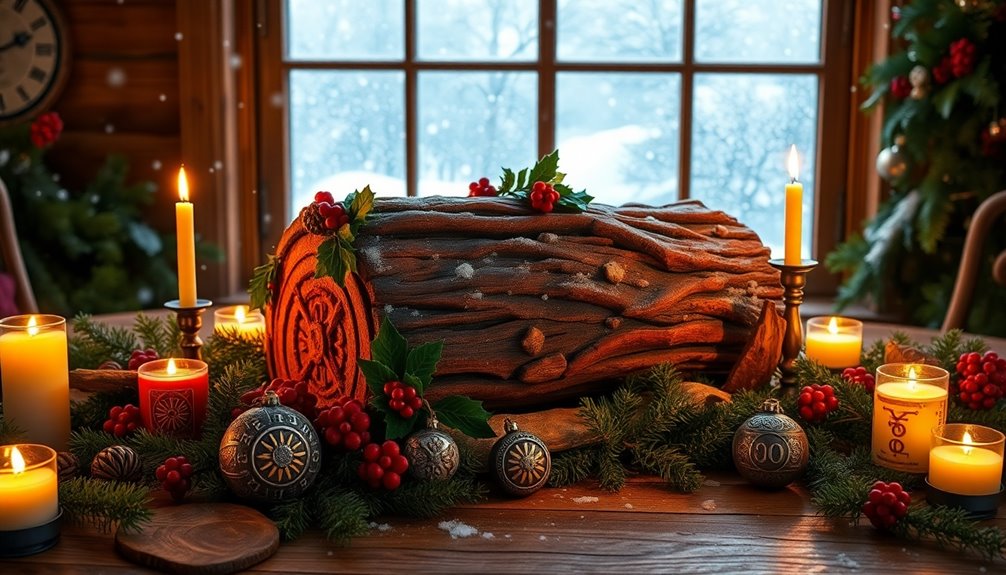
Celebration intertwines with tradition as we explore Yule's significant influence on modern Christmas customs. Yule, celebrated by the Norse people, spanned 12 days filled with feasting, bonfires, and rituals dedicated to fertility and renewal. These pagan celebrations directly shaped various Christmas customs we cherish today.
For instance, gift-giving during Yule paved the way for the Christmas tradition of exchanging presents, emphasizing generosity during the winter solstice.
Another key element is the Yule Log, which symbolizes the warmth of the bonfires once lit to ward off the cold. Today, it's common to see the Yule Log transformed into a festive dessert, illustrating how these ancient traditions have evolved.
The sacred boar, or Yule ham, is also a notable symbol that parallels our modern Christmas ham, further linking the two celebrations.
As you decorate your home for Christmas, think of the traditions that have been absorbed from Yule. The timing of both celebrations around the winter solstice highlights how early Christians sought to honor existing customs, blending them into the Christmas we know today.
Embracing these influences enriches your holiday experience.
Misunderstanding Christmas Tree Origins
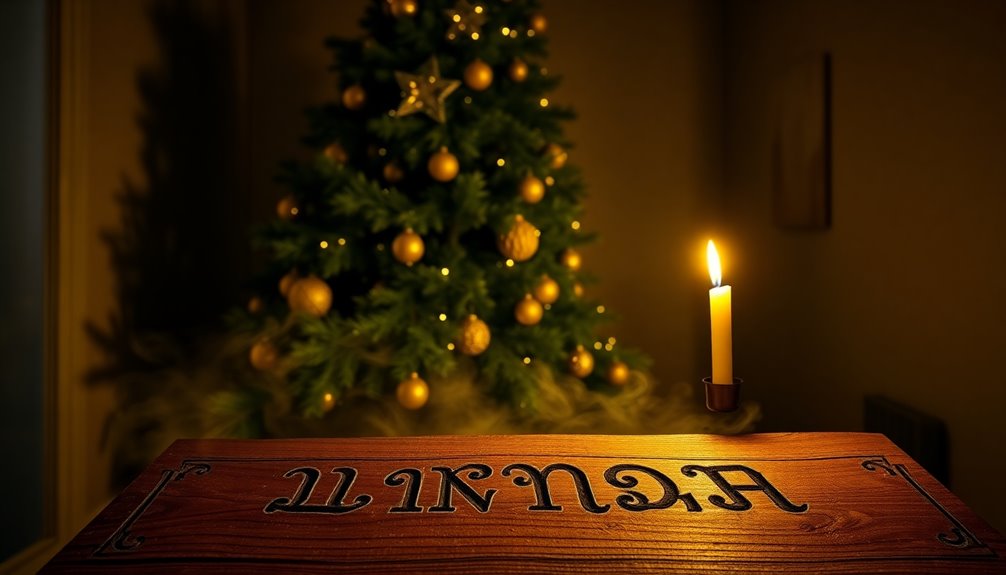
When it comes to Christmas trees, many people misunderstand their origins and significance.
You might hear claims about pagan roots or biblical condemnations, but the reality is more nuanced.
The Christmas tree symbolizes hope and life in the Christian tradition, evolving from earlier practices into a festive celebration of Jesus' birth.
Debunk Christmas Tree Misconceptions
Exploring the origins of the Christmas tree reveals a rich history often misunderstood. Many people link the Christmas tree to pagan practices, but this connection is misleading. The tradition gained popularity in 19th century Germany, where evergreen trees symbolized eternal life—representing hope and renewal associated with the Christian celebration of Christ's Nativity.
While evergreen trees have been used in winter celebrations long before Christmas, Christians adopted them to reflect their beliefs. The misconception that the Christmas tree is rooted in idol worship stems from misinterpretations of passages like Jeremiah 10:3-4, which actually refers to idol worship, not the act of decorating trees for Christmas.
It's important to recognize that the Christmas tree evolved within a Christian context and has gained cultural significance over the years. Instead of viewing it as a remnant of paganism, consider how it embodies the spirit of the Nativity and the joy of the season.
Ultimately, the Christmas tree serves as a symbol of hope and life, aligning with Christian values rather than ancient rituals. Understanding this allows you to appreciate the tree's place in modern celebrations without the weight of misconceptions.
Biblical Condemnation of Tree Worship
The misunderstanding surrounding Christmas trees often leads to the belief that the Bible condemns their use through passages like Jeremiah 10:2-4. Critics often point to these verses as a biblical condemnation of tree worship, but this interpretation misses the mark.
In reality, Jeremiah addresses idolatry and the creation of wooden idols, not the celebration of Christmas trees.
The tradition of decorating Christmas trees actually originated in 16th century Germany. Here, the evergreen tree symbolized eternal life, rooted firmly in a Christian framework celebrating Jesus' birth. While some might attempt to link this practice to pagan traditions, historical evidence shows that the Christmas tree evolved distinctly within Christian culture.
When you look at the context of Jeremiah 10:3-4, it's clear that the passage warns against idol-making rather than condemning the use of trees as symbols of hope and life during the Christmas celebration.
Understanding this distinction helps clarify why Christmas trees don't represent pagan practices but instead embody a joyful Christian celebration.
Community Celebration of Traditions
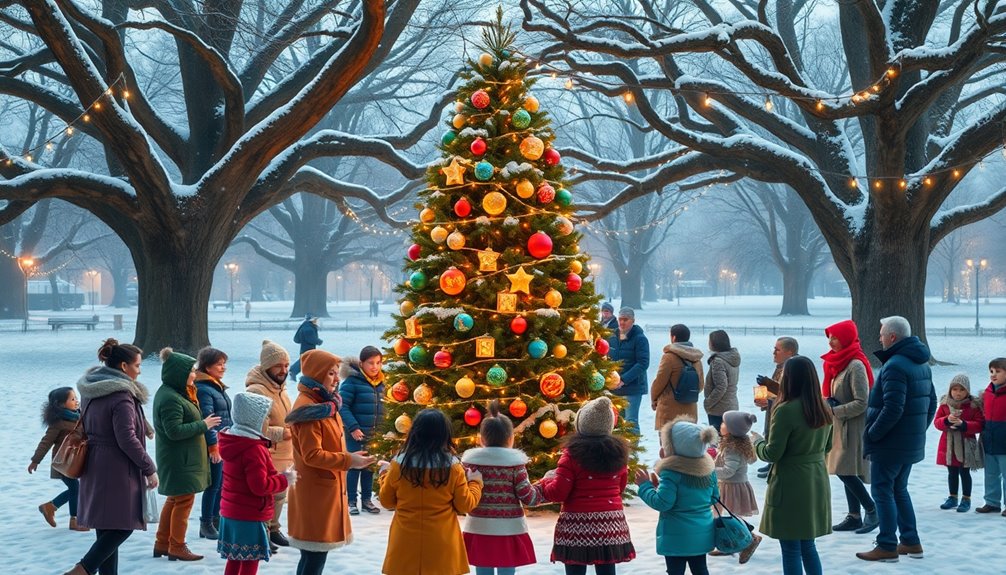
During Christmas, you likely gather with family to share meals and create lasting memories, continuing age-old traditions that foster togetherness.
Many communities also engage in holiday service activities, reinforcing the spirit of giving and compassion that echoes throughout the season.
These celebrations not only honor the past but also strengthen the bonds within your community.
Family Gatherings During Christmas
Christmas brings families together in a vibrant celebration of traditions that blend both Christian and pagan influences. During family gatherings, you'll find shared meals that emphasize community and togetherness, echoing the ancient customs of feasting.
Gift-giving is another cherished practice, rooted in festivals like Saturnalia, where exchanging presents was a way to spread goodwill among loved ones.
As you gather around the Christmas tree, a symbol popularized in the 19th century, you might reflect on its connections to ancient pagan practices representing eternal life. Your home, adorned with holly and mistletoe, echoes traditions once considered sacred by pagan cultures, now embraced as symbols of peace and goodwill during the Christmas season.
Additionally, Christmas caroling fills the air with joy, blending medieval church practices with modern selections that celebrate both secular and religious themes.
These family gatherings create lasting memories, reinforcing the spirit of togetherness and the warmth of community during this festive time. Embracing these rich traditions allows you to honor the past while creating new experiences with your loved ones.
Community Holiday Service Activities
Community holiday service activities bring people together, fostering a sense of unity and purpose during the festive season. During Christmas, these activities often center around charity events, food drives, and toy donations. By participating, you contribute to a spirit of giving that connects everyone involved.
Many communities also organize caroling events and public nativity scenes, offering entertainment while sharing the Christmas story with a wider audience. Local churches frequently hold special Christmas services that include traditions like candlelight vigils and Advent wreaths.
These services emphasize the holiday's religious significance and invite community prayers, nurturing a collective spiritual experience. In addition, winter festivals celebrate diverse cultural traditions through light displays, parades, and festive markets.
These events highlight the richness of various holiday practices and encourage participation from people of all backgrounds. Collaborative efforts among community organizations result in inclusive activities that embody the unifying aspects of the Christmas season.
Ultimately, community holiday service activities not only enrich your holiday experience but also strengthen bonds among neighbors, reminding everyone of the importance of service, charity, and shared traditions during this special time of year.
Cultural Blending Over Centuries
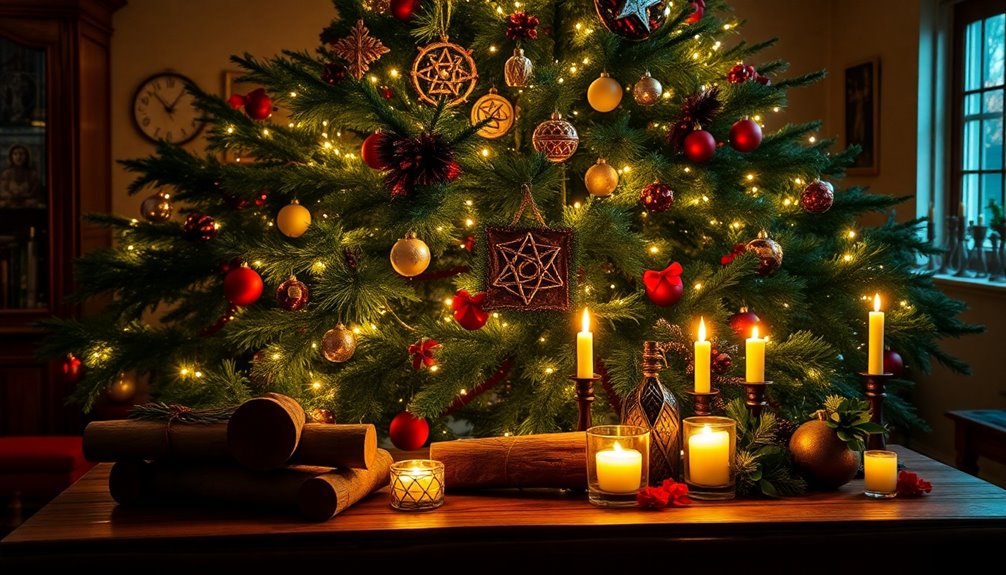
Cultural acceptance has shaped the way Christmas is celebrated today, blending elements from various traditions over the centuries. Initially, early Christians positioned Christmas on December 25 to coincide with pagan winter solstice festivals, fostering cultural blending and acceptance of new practices.
One significant influence was Saturnalia, a festival celebrated from December 17 to 24, which introduced customs like feasting and gift-giving that became integral to modern Christmas traditions.
Additionally, Norse Yule celebrations, lasting 12 days, contributed unique elements such as bonfires and the sacred Yule ham. These customs echoed in later Christmas festivities, enriching the holiday's symbolism.
The adoption of pagan customs, like decorating with evergreen trees and holly, illustrates how early Christians embraced and transformed these practices, making them central to today's Christmas celebrations.
As Christmas evolved, especially in 19th-century America, immigrant traditions further enriched the holiday. This cultural blending reshaped Christmas into a diverse celebration that reflects various heritages.
In the modern world, what you see during Christmas is a tapestry woven from many traditions, showcasing how cultural acceptance has created a holiday filled with shared joy and meaning.
Additional Resources
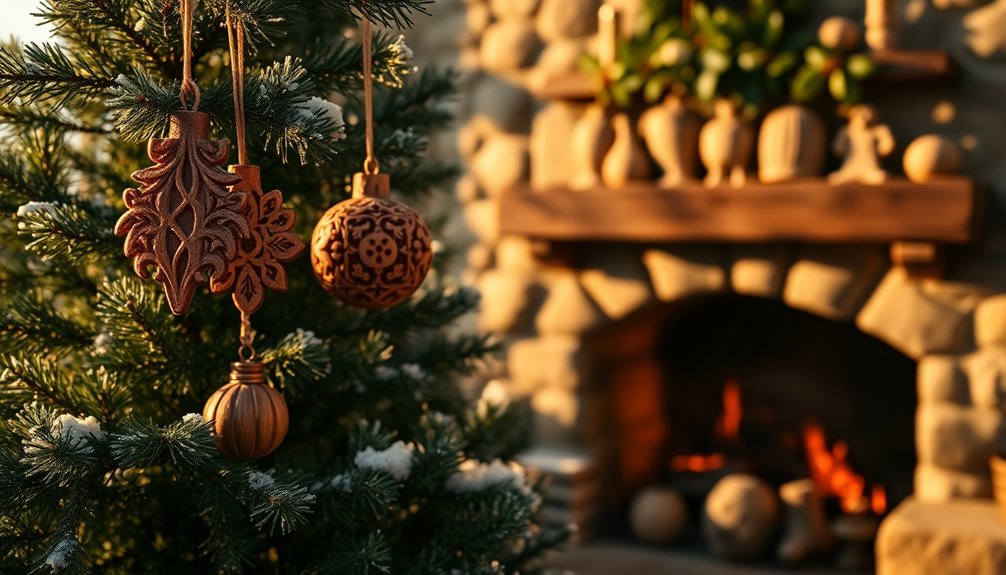
Understanding the rich history and diverse traditions surrounding Christmas can be enhanced by exploring various resources available on the topic. Books, articles, and documentaries delve into how Christmas became a significant Christian holiday celebrating the birth of Jesus. These resources clarify misconceptions about its alleged pagan origins, focusing instead on the holiday's purpose: to celebrate the birth of the light of the world.
You can discover how ancient Christian communities established December 25 as a key date, coinciding with winter solstice festivals without deriving the celebration directly from them. Investigating historical contexts will reveal how customs like feasting and gift-giving, common practices in pagan holidays like Saturnalia and Yule, were reinterpreted within a Christian framework.
Online courses and lectures can offer deeper insights into cultural syncretism, showing how Christmas absorbed various traditions while maintaining its core focus on the Nativity.
Frequently Asked Questions
Is Christmas Based off a Pagan Holiday?
You might wonder if Christmas is based on a pagan holiday.
While some customs like gift-giving and using evergreen trees have roots in earlier celebrations, the date and significance of December 25 primarily focus on Jesus' birth.
Early Christians adapted certain traditions to create a holiday that emphasizes hope and renewal, rather than worshipping pagan deities.
What Is the True Origin of Christmas Day?
The true origin of Christmas Day dates back to early Christianity in the 4th century, when church leaders chose December 25 to celebrate the birth of Jesus.
This date aligns with ancient winter solstice festivals, aiming to attract pagans to the new faith.
Over time, Christmas traditions evolved, incorporating customs like feasting and gift-giving.
You'll find that while some elements are inspired by pagan practices, the holiday has developed its own unique identity.
Was December 25TH Originally a Pagan Holiday?
You might wonder if December 25th was originally a pagan holiday.
While some ancient festivals celebrated around the winter solstice occurred before Christmas, they weren't directly linked to it.
Early Christians chose this date to honor Jesus' birth, recognizing its significance rather than appropriating pagan traditions.
The celebrations you see today stem from a Christian initiative, emphasizing hope and renewal rather than pagan roots.
Does the Bible Say Not to Celebrate Pagan Holidays?
The Bible doesn't explicitly say you shouldn't celebrate pagan holidays. Instead, it emphasizes worshiping God and avoiding idolatry.
In Colossians 2:16-17, you're encouraged to enjoy your freedom in choosing how to observe festivals.
Romans 14:5-6 suggests that your personal convictions matter more than strict rules.
Ultimately, it's about your conscience and the meaning you find in the celebration, rather than adhering to prohibitions against specific holidays.

